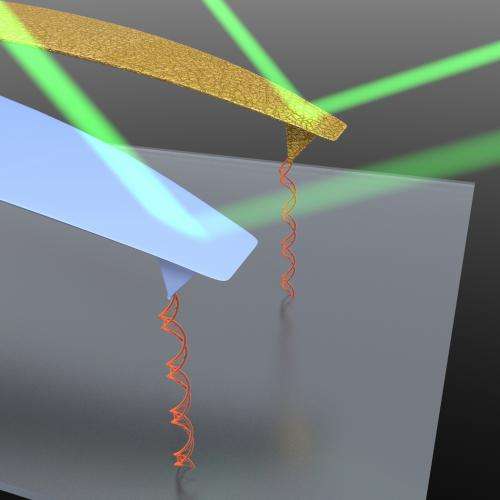Not-so-precious: Stripping gold from AFM probes allows better measurement of picoscale forces

(Phys.org) -- Gold is not necessarily precious—at least not as a coating on atomic force microscope (AFM) probes.
JILA researchers found that removing an AFM probe's gold coating—until now considered helpful—greatly improved force measurements performed in a liquid, the medium favored for biophysical studies such as stretching DNA or unfolding proteins. As described in Nano Letters,* stripping the gold from the diving-board-shaped probe, or cantilever, with a brief chemical bath improved the precision and stability of force measurements about 10-fold. The advance is expected to quickly and broadly benefit the fields of biophysics and nanoscience.
JILA is a joint institute of the National Institute of Standards and Technology (NIST) and the University of Colorado Boulder.
"What I find interesting about this experiment is it's so incredibly simple. It takes a minute to strip the gold off a commercial cantilever and you get a 10-fold improvement in force precision," says NIST/JILA physicist Thomas Perkins.
To measure forces at the molecular scale, an AFM's cantilever attaches to a molecule with its pointed end and pulls; the resulting deflection of the cantilever is measured. The forces are in the realm of piconewtons (pN), or trillionths of a newton. A unit of force, one newton is roughly the weight of a small apple.
Cantilevers are typically made of silicon or silicon nitride and coated with gold on both sides to reflect light. Perkins discovered the gold coating was a problem while his research group was probing the folding and unfolding of protein molecules over time periods of seconds to minutes. The group previously improved AFM position stability** and holds a related patent,*** but then discovered that the force was drifting. "It's counterintuitive," says Perkins. "Everyone has assumed you needed gold for the enhanced reflectivity, when in fact, gold is clearly the dominant source of force drift on short and long time scales."
"Gold exhibits a sort of complex elastic property in high-precision measurements," Perkins explains. "When you bend gold, it creeps a little bit, like silly putty. Further, the lore in the field is that gold can crack, it can age, and molecules can bind to it—all of which may change its mechanical properties. This problem is even worse when you do biological experiments in liquid."
AFM force measurements in liquid typically have had precision (error range) of plus or minus 5 to 10 pN. By stripping the gold JILA researchers reduced the error by 10 times, to about 0.5 pN for measurements on both short and long timescales. Researchers can now precisely measure fast processes, such as proteins folding and unfolding 50 times per second, over long time periods of several minutes. Significantly, the results were achieved with commercially available microscopes and cantilevers, so the practical benefits can be applied quickly for any AFM force measurements and imaging. AFM can now compete with optical traps and magnetic tweezers in terms of sensitivity.
More information: * A.B. Churnside, R.M.A. Sullan, D.M. Nguyen, S.O. Case, M.S. Bull, G.M. King and T.T. Perkins. Routine and timely sub-piconewton force stability and precision for biological applications of atomic force microscopy. Nano Letters. Published online June 13.
** See the Mar. 24, 2009, article, "Making a Point: Picoscale Stability in a Room-Temperature AFM" at phys.org/news157206337.html
*** U.S. Patent 7,928,409, April 19, 2011, Real-time, active picometer-scale alignment, stabilization and registration in one or more dimensions, T.T. Perkins, G.M. King and A.R. Carter.
Journal information: Nano Letters
Provided by National Institute of Standards and Technology




















